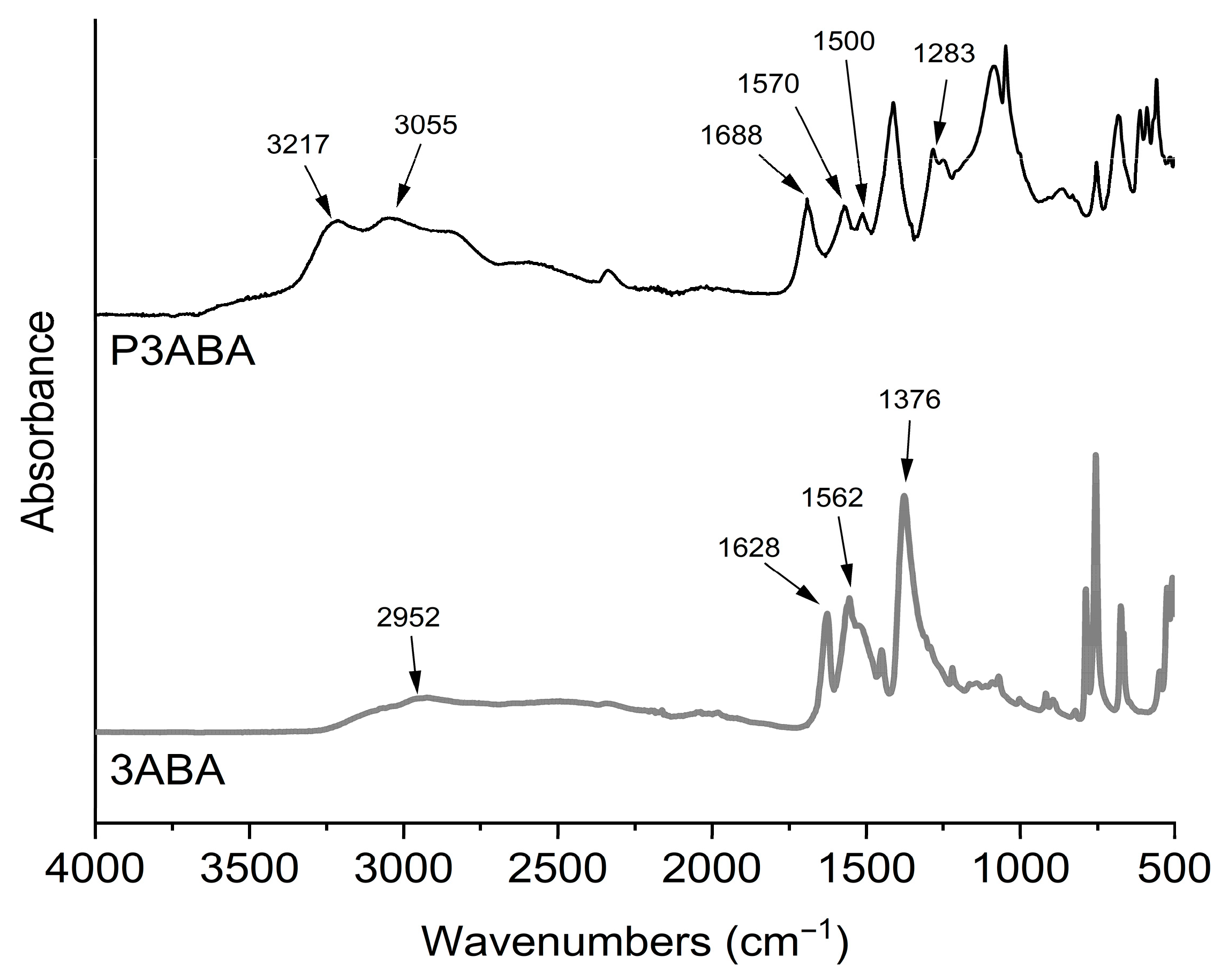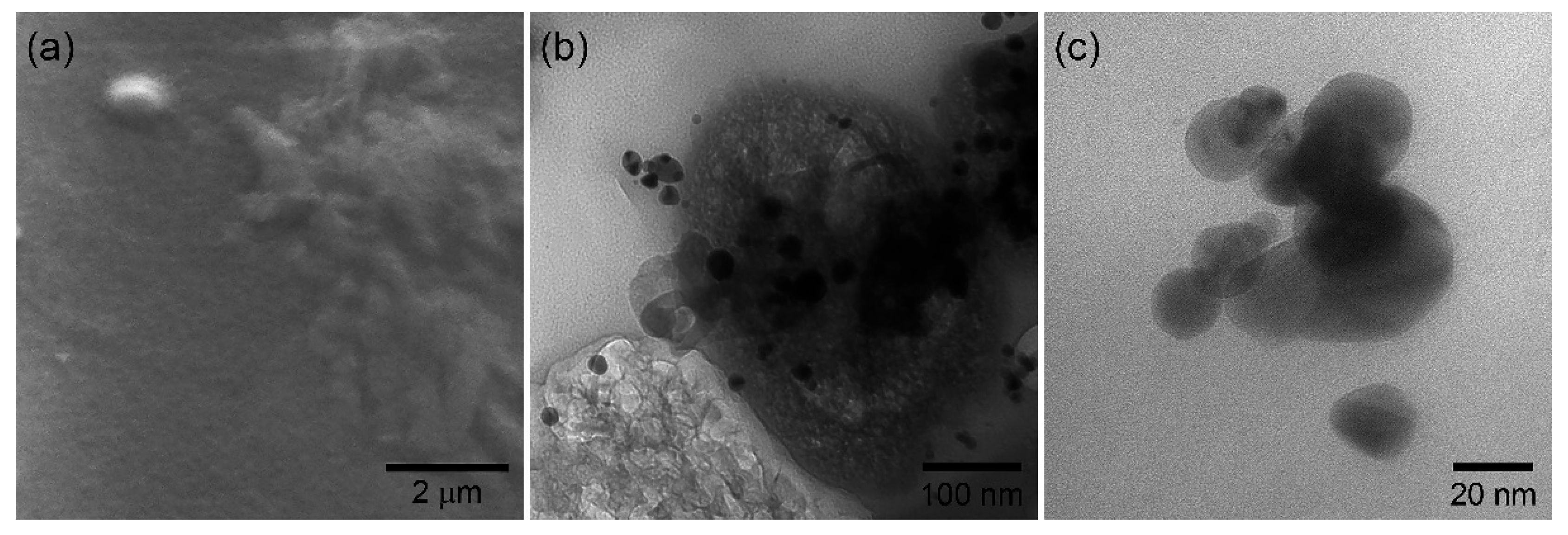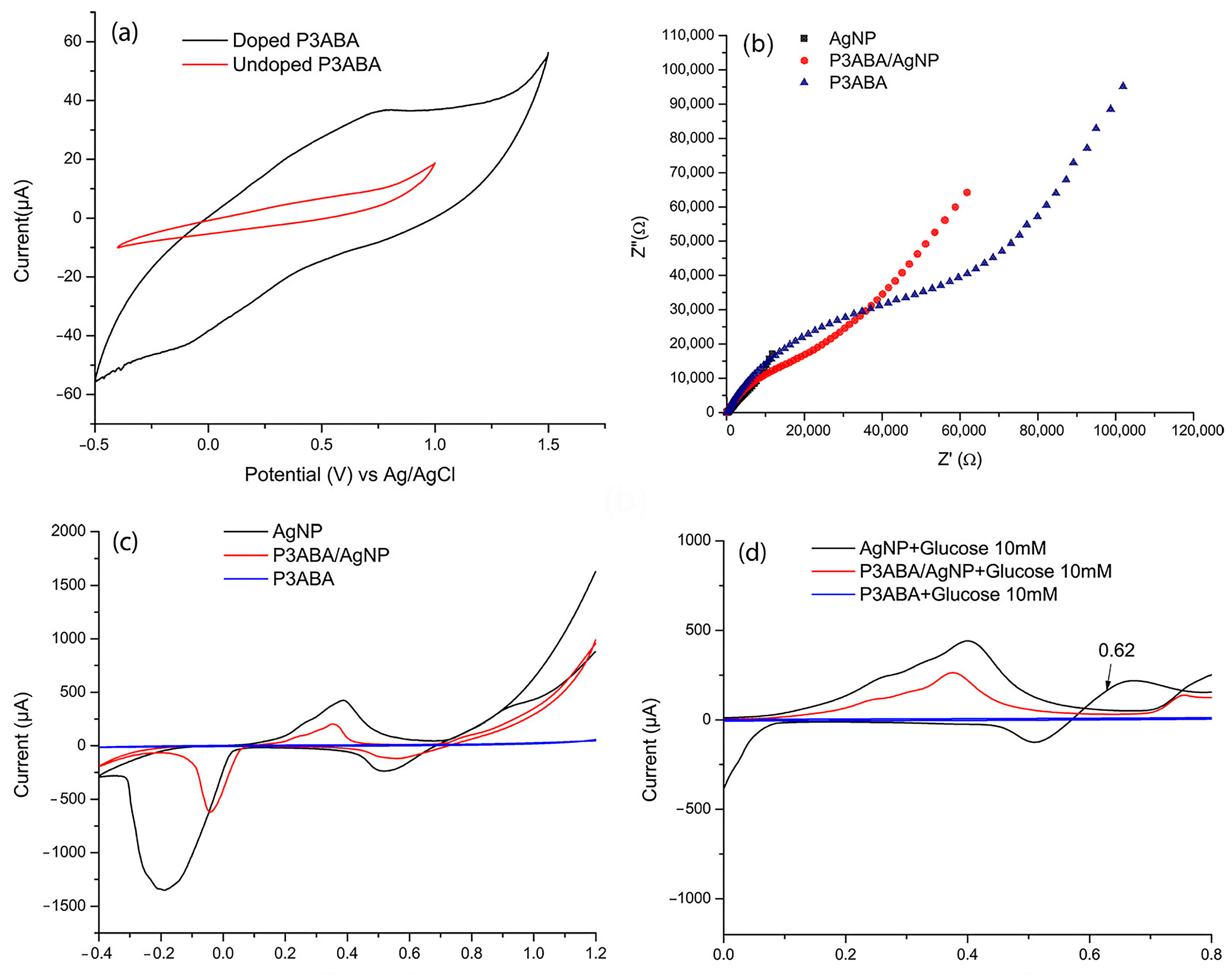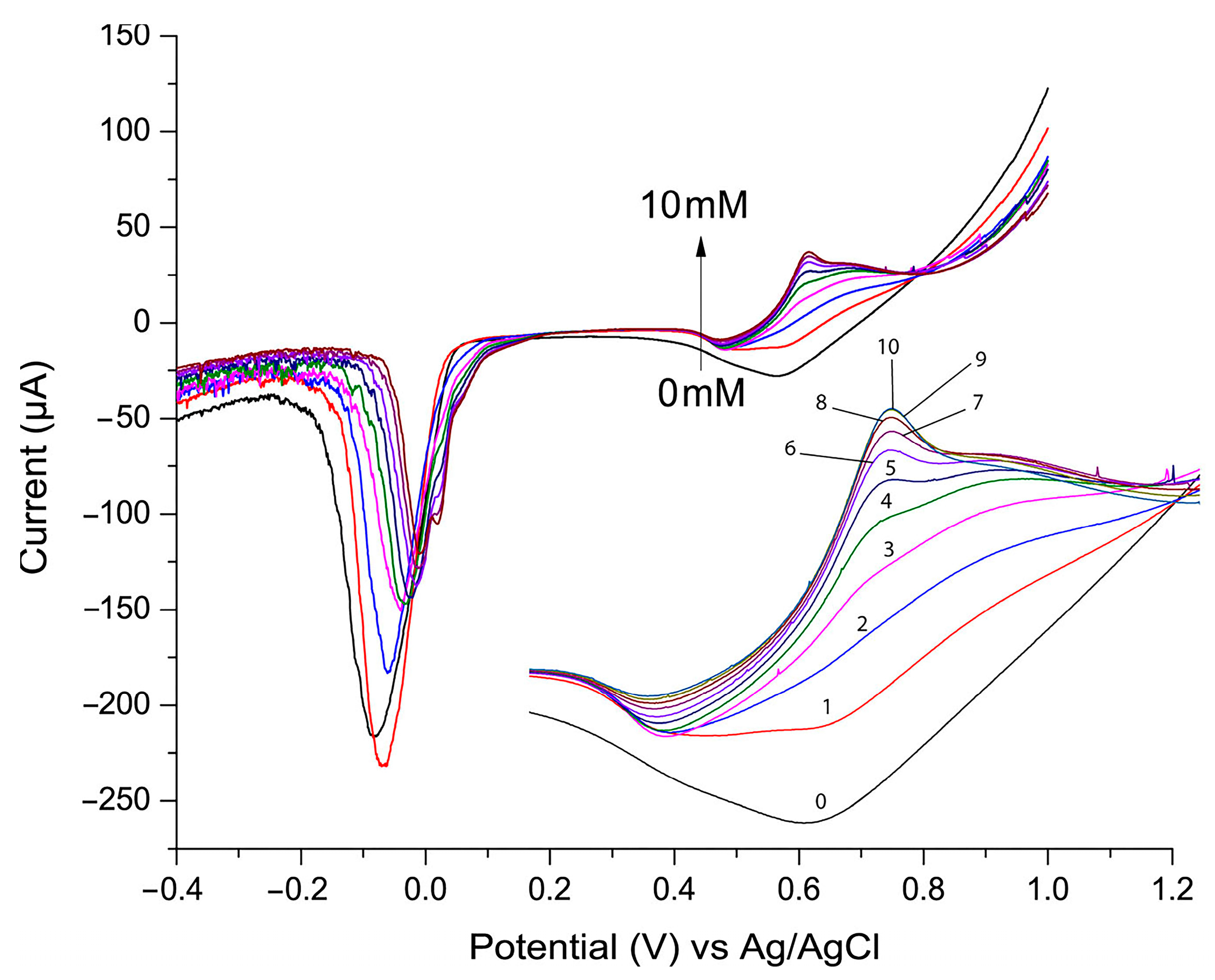Non-Enzymatic Electrochemical Sensing of Glucose with Silver Nanoparticles Supported on Poly(3-aminobenzoic acid)
Abstract
:1. Introduction
2. Materials and Methods
2.1. Synthesis of Poly(3-aminobenzoic acid) (P3ABA)
2.2. Synthesis of Silver Nanoparticles (AgNPs)
2.3. Preparation and Modification of Glassy Carbon Electrode (GCE)
3. Results
3.1. FTIR Characterization
3.2. Morphological Characterization
3.3. Electrochemical Behavior of GCE-Modified Electrode
3.4. Preliminary Study of Glucose Detection
3.5. Calculus of Electroactive Area and Glucose Detection Assay by Chronoamperometry
3.6. Interference Test
3.7. Figure of Merit
4. Conclusions
Supplementary Materials
Author Contributions
Funding
Data Availability Statement
Acknowledgments
Conflicts of Interest
References
- Mahmudiono, T.; Olegovich Bokov, D.; Abdalkareem Jasim, S.; Abdelbasset, W.K.; Dinora, M.K. State-of-the-Art of Convenient and Low-Cost Electrochemical Sensor for Food Contamination Detection: Technical and Analytical Overview. Microchem. J. 2022, 179, 107460. [Google Scholar] [CrossRef]
- Falone, M.F.; Buffon, E.; Stradiotto, N.R. Molecularly Imprinted Electrochemical Sensor for Monitoring Mercaptan Sulfur in Aviation Biofuel. Fuel 2022, 307, 121783. [Google Scholar] [CrossRef]
- Atta, N.F.; Galal, A.; El-Ads, E.H. Effect of B-Site Doping on Sr2PdO3 Perovskite Catalyst Activity for Non-Enzymatic Determination of Glucose in Biological Fluids. J. Electroanal. Chem. 2019, 852, 113523. [Google Scholar] [CrossRef]
- Amor-Gutiérrez, O.; Costa-Rama, E.; Fernández-Abedul, M.T. Paper-Based Enzymatic Electrochemical Sensors for Glucose Determination. Sensors 2022, 22, 6232. [Google Scholar] [CrossRef] [PubMed]
- Dong, Q.; Ryu, H.; Lei, Y. Metal Oxide Based Non-Enzymatic Electrochemical Sensors for Glucose Detection. Electrochim. Acta 2021, 370, 137744. [Google Scholar] [CrossRef]
- Beaver, K.; Dantanarayana, A.; Minteer, S.D. Materials Approaches for Improving Electrochemical Sensor Performance. J. Phys. Chem. B 2021, 125, 11820–11834. [Google Scholar] [CrossRef] [PubMed]
- Zaabal, M.; Bakirhan, N.K.; Doulache, M.; Kaddour, S.; Saidat, B.; Ozkan, S.A. A New Approach on Sensitive Assay of Adefovir in Pharmaceutical and Biological Fluid Samples Using Polypyrrole Modified Glassy Carbon Electrode. Sens. Actuators B Chem. 2020, 323, 128657. [Google Scholar] [CrossRef]
- Ruecha, N.; Rodthongkum, N.; Cate, D.M.; Volckens, J.; Chailapakul, O.; Henry, C.S. Sensitive Electrochemical Sensor Using a Graphene-Polyaniline Nanocomposite for Simultaneous Detection of Zn(II), Cd(II), and Pb(II). Anal. Chim. Acta 2015, 874, 40–48. [Google Scholar] [CrossRef]
- Molina, B.G.; Del Valle, L.J.; Turon, P.; Armelin, E.; Alemán, C. Electrochemical Sensor for Bacterial Metabolism Based on the Detection of NADH by Polythiophene Nanoparticles. J. Phys. Chem. C 2019, 123, 22181–22190. [Google Scholar] [CrossRef]
- Ramkumar, R.; Sangaranarayanan, M.V. Electrochemical Sensing of Anesthetics Using Polythiophene Coated Glassy Carbon Electrodes. ChemistrySelect 2019, 4, 9776–9783. [Google Scholar] [CrossRef]
- Piñón-Balderrama, C.I.; Hernández-Escobar, C.A.; Reyes-López, S.Y.; Conejo-Dávila, A.S.; Estrada-Monje, A.; Zaragoza-Contreras, E.A. Non-Enzymatic Electrochemical Sensing of Glucose with a Carbon Black/Polyaniline/Silver Nanoparticle Composite. Chemosensors 2024, 12, 26. [Google Scholar] [CrossRef]
- Zhang, Y.; Zhang, Y.; Zhu, H.; Li, S.; Jiang, C.; Blue, R.J.; Su, Y. Functionalization of the Support Material Based on N-Doped Carbon-Reduced Graphene Oxide and Its Influence on the Non-Enzymatic Detection of Glucose. J. Alloys Compd. 2019, 780, 98–106. [Google Scholar] [CrossRef]
- Zheng, W.; Hu, L.; Lee, L.Y.S.; Wong, K.Y. Copper Nanoparticles/Polyaniline/Graphene Composite as a Highly Sensitive Electrochemical Glucose Sensor. J. Electroanal. Chem. 2016, 781, 155–160. [Google Scholar] [CrossRef]
- Aksun Baykara, E.; Üğe, A.; Gençoğlu, M.; Genys, P.; Koyuncu Zeybek, D.; Gök, Ö.; Ramanavicius, A.; Zeybek, B. A Hybrid Structure Based on Poly(p-Phenylenediamine) and Multi-Walled Carbon Nanotubes Decorated with Silver Nanoparticles: A Highly Selective Platform for Electrochemical Sensing of Dopamine and Acetaminophen. Microchem. J. 2024, 205, 111387. [Google Scholar] [CrossRef]
- Norouzi, B.; Mirkazemi, T. Electrochemical Sensor for Amoxicillin Using Cu/Poly (o-Toluidine) (Sodium Dodecyl Sulfate) Modified Carbon Paste Electrode. Russ. J. Electrochem. 2016, 52, 37–45. [Google Scholar] [CrossRef]
- Zhu, W.; Huang, H.; Gao, X.; Ma, H. Electrochemical Behavior and Voltammetric Determination of Acetaminophen Based on Glassy Carbon Electrodes Modified with Poly(4-Aminobenzoic Acid)/Electrochemically Reduced Graphene Oxide Composite Films. Mater. Sci. Eng. C 2014, 45, 21–28. [Google Scholar] [CrossRef]
- Yang, L.; Zhao, F.; Zeng, B. Electrochemical Determination of Eugenol Using a Three-Dimensional Molecularly Imprinted Poly (p-Aminothiophenol-Co-p-Aminobenzoic Acids) Film Modified Electrode. Electrochim. Acta 2016, 210, 293–300. [Google Scholar] [CrossRef]
- Xu, X.L.; Huang, F.; Zhou, G.L.; Zhang, S.; Kong, J.L. A Novel Electrochemical Sensor for Probing Doxepin Created on a Glassy Carbon Electrode Modified with Poly(4-Amino- Benzoic Acid)/Multi-Walled Carbon Nanotubes Composite Film. Sensors 2010, 10, 8398–8410. [Google Scholar] [CrossRef]
- Shi, L.; Wang, Z.; Yang, G.; Yang, H.; Zhao, F. A Novel Electrochemical Immunosensor for Aflatoxin B1 Based on Au Nanoparticles-Poly 4-Aminobenzoic Acid Supported Graphene. Appl. Surf. Sci. 2020, 527, 146934. [Google Scholar] [CrossRef]
- Yang, L.; Xu, B.; Ye, H.; Zhao, F.; Zeng, B. A Novel Quercetin Electrochemical Sensor Based on Molecularly Imprinted Poly(Para-Aminobenzoic Acid) on 3D Pd Nanoparticles-Porous Graphene-Carbon Nanotubes Composite. Sens. Actuators B Chem. 2017, 251, 601–608. [Google Scholar] [CrossRef]
- Liu, X.; Luo, L.; Zhang, Y.; Ding, Y. Electropolymerization of 4-Aminobenzoic Acid Containing Nano-Au Deposited on Carbon Paste Electrode for Determination of Acetaminophen. J. Iran. Chem. Res. 2012, 5, 161–171. [Google Scholar]
- Sriwichai, S.; Baba, A.; Phanichphant, S.; Shinbo, K.; Kato, K.; Kaneko, F. Electrochemically Controlled Surface Plasmon Resonance Immunosensor for the Detection of Human Immunoglobulin G on Poly(3-Aminobenzoic Acid) Ultrathin Films. Sens. Actuators B Chem. 2010, 147, 322–329. [Google Scholar] [CrossRef]
- Asiri, A.M.; Adeosun, W.A.; Marwani, H.M.; Rahman, M.M. Homopolymerization of 3-Aminobenzoic Acid for Enzyme-Free Electrocatalytic Assay of Nitrite Ions. New J. Chem. 2020, 44, 2022–2032. [Google Scholar] [CrossRef]
- Shishkanova, T.V.; Broncová, G.; Němečková, Z.; Vrkoslav, V.; Král, V.; Matějka, P. Molecular Frameworks of Polymerized 3-aminobenzoic Acid for Chemical Modification and Electrochemical Recognition. J. Electroanal. Chem. 2019, 832, 321–328. [Google Scholar] [CrossRef]
- Shishkanova, T.V.; Pospíšilová, E.; Trchová, M.; Broncová, G. Zwitterionic Oligomers of 3-Aminobenzoic Acid on Screen-Printed Electrodes: Structure, Properties and Forensic Application. Analyst 2024, 149, 1121–1131. [Google Scholar] [CrossRef]
- Pimalai, D.; Putnin, T.; Bamrungsap, S. A Highly Sensitive Electrochemical Sensor Based on Poly(3-Aminobenzoic Acid)/Graphene Oxide-Gold Nanoparticles Modified Screen Printed Carbon Electrode for Paraquat Detection. J. Environ. Sci 2025, 148, 139–150. [Google Scholar] [CrossRef]
- Nehru, R.; Chen, T.W.; Chen, S.M.; Tseng, T.W.; Liu, X. 4-Nitrophenol Detection in Water Sample Using Linear Sweep Voltammetry with f-Multi Walled Carbon Nanotubes Modified Electrode. Int. J. Electrochem. Sci. 2018, 13, 7778–7788. [Google Scholar] [CrossRef]
- Sukanya, R.; Aruldhas, D.; HubertJoe, I.; Balachandran, S. Synthesis, Spectroscopic (FTIR, FT-Raman and UV-Vis), Structural Investigation, Chemical Reactivity, AIM, NBO, NLO, Hirshfeld Analysis of 4-Aminobenzoic Acid Pyrazinoic Acid. Polycycl. Aromat. Compd. 2023, 44, 25–50. [Google Scholar]
- Öztürk, T.; Gülfen, M.; Özdemir, A. Sorption of Pt(IV) Ions on Poly(m-Aminobenzoic Acid) Chelating Polymer: Equilibrium, Kinetic and Thermodynamic Studies. SN Appl. Sci. 2020, 2, 1886. [Google Scholar] [CrossRef]
- Rivas, B.L.; Sánchez, C.O. Poly(2-) and (3-Aminobenzoic Acids) and Their Copolymers with Aniline: Synthesis, Characterization, and Properties. J. Appl. Polym. Sci. 2003, 89, 2641–2648. [Google Scholar]
- Benyoucef, A.; Huerta, F.; Vázquez, J.L.; Morallon, E. Synthesis and in Situ FTIRS Characterization of Conducting Polymers Obtained from Aminobenzoic Acid Isomers at Platinum Electrodes. Eur. Polym. J. 2005, 41, 843–852. [Google Scholar] [CrossRef]
- Stejskal, J.; Sapurina, I.; Trchová, M. Polyaniline Nanostructures and the Role of Aniline Oligomers in Their Formation. Prog. Polym. Sci. 2010, 35, 1420–1481. [Google Scholar] [CrossRef]
- Huang, K.J.; Xu, C.X.; Xie, W.Z.; Wang, W. Electrochemical Behavior and Voltammetric Determination of Tryptophan Based on 4-Aminobenzoic Acid Polymer Film Modified Glassy Carbon Electrode. Colloids Surf. B Biointerfaces 2009, 74, 167–171. [Google Scholar] [CrossRef]
- Osuna, V.; Vega-Rios, A.; Zaragoza-Contreras, E.A.; Estrada-Moreno, I.A.; Dominguez, R.B. Progress of Polyaniline Glucose Sensors for Diabetes Mellitus Management Utilizing Enzymatic and Non-Enzymatic Detection. Biosensors 2022, 12, 137. [Google Scholar] [CrossRef]
- Yamada, H.; Yoshii, K.; Asahi, M.; Chiku, M.; Kitazumi, Y. Cyclic Voltammetry Part 1: Fundamentals†. Electrochemistry 2022, 90, 102005. [Google Scholar] [CrossRef]
- Quan, H.; Park, S.U.; Park, J. Electrochemical Oxidation of Glucose on Silver Nanoparticle-Modified Composite Electrodes. Electrochim. Acta 2010, 55, 2232–2237. [Google Scholar] [CrossRef]
- Piñón-Balderrama, C.I.; Manríquez-Tristán, A.; Maldonado-Orozco, M.C.; Hernández-Escobar, C.A.; Reyes-López, S.Y.; Espinosa-Cristobal, L.F.; Zaragoza-Contreras, E.A. Lithium Niobate Perovskite as the Support for Silver Nanoparticles for Non-Enzymatic Electrochemical Detection of Glucose. Chemosensors 2024, 12, 210. [Google Scholar] [CrossRef]
- El Henawee, M.; Saleh, H.; Attia, A.K.; Hussien, E.M.; Derar, A.R. Carbon Nanotubes Bulk Modified Printed Electrochemical Sensor for Green Determination of Vortioxetine Hydrobromide by Linear Sweep Voltammetry. Measurement 2021, 177, 109239. [Google Scholar] [CrossRef]
- Ivanišević, I. The Role of Silver Nanoparticles in Electrochemical Sensors for Aquatic Environmental Analysis. Sensors 2023, 23, 3692. [Google Scholar] [CrossRef]
- Youcef, M.; Hamza, B.; Nora, H.; Walid, B.; Salima, M.; Ahmed, B.; Malika, F.; Marc, S.; Christian, B.; Wassila, D.; et al. A Novel Green Synthesized NiO Nanoparticles Modified Glassy Carbon Electrode for Non-Enzymatic Glucose Sensing. Microchem. J. 2022, 178, 107332. [Google Scholar] [CrossRef]
- Rahmanipour, M.; Siampour, H.; Amirsoleimani, A.R.; Rezazadeh, M.; Moshaii, A. Cu-Ag Bimetallic Nanostructures with High Glucose Sensing Performance Fabricated by a Scalable and Reproducible Method. Microchem. J. 2023, 193, 109208. [Google Scholar] [CrossRef]
- Siampour, H.; Abbasian, S.; Moshaii, A. Copper Columnar Nanostructures Fabricated by Glancing Angle Deposition as a Robust and Scalable Method for High Sensitive Non-Enzymatic Glucose Detection. Appl. Surf. Sci. 2020, 518, 146182. [Google Scholar] [CrossRef]
- Metelka, R.; Vlasáková, P.; Smarzewska, S.; Guziejewski, D.; Vlček, M.; Sýs, M. Screen-Printed Carbon Electrodes with Macroporous Copper Film for Enhanced Amperometric Sensing of Saccharides. Sensors 2022, 22, 3466. [Google Scholar] [CrossRef]
- Ashok, A.; Kumar, A.; Tarlochan, F. Highly Efficient Nonenzymatic Glucose Sensors Based on CuO Nanoparticles. Appl. Surf. Sci. 2019, 481, 712–722. [Google Scholar] [CrossRef]
- Deshmukh, M.A.; Kang, B.C.; Ha, T.J. Non-Enzymatic Electrochemical Glucose Sensors Based on Polyaniline/Reduced-Graphene-Oxide Nanocomposites Functionalized with Silver Nanoparticles. J. Mater. Chem. C Mater. 2020, 8, 5112–5123. [Google Scholar] [CrossRef]
- Zalke, J.B.; Narkhede, N.P.; Rotake, D.R.; Govind Singh, S. Facile Chemiresistive Biosensor Functionalized with PANI/GOx and Novel Green Synthesized Silver Nanoparticles for Glucose Sensing. Microchem. J. 2024, 200, 110339. [Google Scholar] [CrossRef]
- Xu, M.; Song, Y.; Ye, Y.; Gong, C.; Shen, Y.; Wang, L.; Wang, L. A Novel Flexible Electrochemical Glucose Sensor Based on Gold Nanoparticles/Polyaniline Arrays/Carbon Cloth Electrode. Sens. Actuators B Chem. 2017, 252, 1187–1193. [Google Scholar] [CrossRef]
- Phetsang, S.; Jakmunee, J.; Mungkornasawakul, P.; Laocharoensuk, R.; Ounnunkad, K. Sensitive Amperometric Biosensors for Detection of Glucose and Cholesterol Using a Platinum/Reduced Graphene Oxide/Poly(3-Aminobenzoic Acid) Film-Modified Screen-Printed Carbon Electrode. Bioelectrochemistry 2019, 127, 125–135. [Google Scholar] [CrossRef]







| Potential (V) | Potential SD (V) | Current (µA) | Current SD (µA) | Linear Range mol L−1 | Correlation Coefficient | Slope (µA mM−1) | Slope SD (µA mM−1) | b | b SD |
|---|---|---|---|---|---|---|---|---|---|
| 0.63 | 0.0012 | 86 | 0.41 | 1–16 | 0.9989 | 3.5 | 0.03 | 3.6 | 0.09 |
| Electrocatalytic Material | Saccharide | LOD (µM) | Sensitivity (µA mM−1 cm−2) | LR (mM) | Detection Medium | Selectivity | Ref |
|---|---|---|---|---|---|---|---|
| NiO | Glucose | 3.2 | 987.85 | 1–10 | PBS | BS | [40] |
| CuAg | Glucose | 1.33 | 3802 | 3–8 | NaOH | UA, AA, L, S, Ma | [41] |
| Cu | Glucose | 0.048 | 1862 | 2–8 | NaOH | UA, AA, L, F, Ma, S | [42] |
| Cu | Fructose | 0.5 | 50.47 | 0.01–0.3 | NaOH | UA, AA | [43] |
| CuO | Glucose | 0.25 | 2062 | 0.01–0.85 | NaOH | AA, DA, NaCl, F, S, L | [44] |
| PANI/rGO/AgNP | Glucose | 0.79 | 2766.4 | 0.05–0.0001 | PBS | BS | [45] |
| CB/PANI/AgNP | Glucose | 520 | 41.26 | 1–10 | NaOH | KCl, NaCl, U | [11] |
| PANI/GOx/AGNP | Glucose | 0.198 | 291.19 | 0.198 | PBS | UA, AA, F, L, G, M | [46] |
| PANI/CC/AuNP | Glucose | 3.08 | 150 | --- | KOH | NaCl, KCl, AA, UA, A, F, G | [47] |
| Cu | Sucrose | 0.05 | 54 | 0.004–0.1 | NaOH | UA, AA | [43] |
| Pt/rGO/P3ABA | Glucose | 44.3 | 22.01 | 0.25–6 | PBS | Cho, AA, UA, S | [48] |
| P3ABA/AgNP | Glucose | 0.3 | 50.71 | 1–16 | NaOH | NaCl, KCl, U, Cr, F | This work |
Disclaimer/Publisher’s Note: The statements, opinions and data contained in all publications are solely those of the individual author(s) and contributor(s) and not of MDPI and/or the editor(s). MDPI and/or the editor(s) disclaim responsibility for any injury to people or property resulting from any ideas, methods, instructions or products referred to in the content. |
© 2025 by the authors. Licensee MDPI, Basel, Switzerland. This article is an open access article distributed under the terms and conditions of the Creative Commons Attribution (CC BY) license (https://creativecommons.org/licenses/by/4.0/).
Share and Cite
Mares-García, A.S.; Hernández-Escobar, C.A.; Enriquez-Durán, S.K.; Estrada-Monje, A.; Zaragoza-Contreras, E.A.; Piñón-Balderrama, C.I. Non-Enzymatic Electrochemical Sensing of Glucose with Silver Nanoparticles Supported on Poly(3-aminobenzoic acid). Chemosensors 2025, 13, 133. https://doi.org/10.3390/chemosensors13040133
Mares-García AS, Hernández-Escobar CA, Enriquez-Durán SK, Estrada-Monje A, Zaragoza-Contreras EA, Piñón-Balderrama CI. Non-Enzymatic Electrochemical Sensing of Glucose with Silver Nanoparticles Supported on Poly(3-aminobenzoic acid). Chemosensors. 2025; 13(4):133. https://doi.org/10.3390/chemosensors13040133
Chicago/Turabian StyleMares-García, América Susana, Claudia Alejandra Hernández-Escobar, Sonia Kimberly Enriquez-Durán, Anayansi Estrada-Monje, Erasto Armando Zaragoza-Contreras, and Claudia Ivone Piñón-Balderrama. 2025. "Non-Enzymatic Electrochemical Sensing of Glucose with Silver Nanoparticles Supported on Poly(3-aminobenzoic acid)" Chemosensors 13, no. 4: 133. https://doi.org/10.3390/chemosensors13040133
APA StyleMares-García, A. S., Hernández-Escobar, C. A., Enriquez-Durán, S. K., Estrada-Monje, A., Zaragoza-Contreras, E. A., & Piñón-Balderrama, C. I. (2025). Non-Enzymatic Electrochemical Sensing of Glucose with Silver Nanoparticles Supported on Poly(3-aminobenzoic acid). Chemosensors, 13(4), 133. https://doi.org/10.3390/chemosensors13040133






